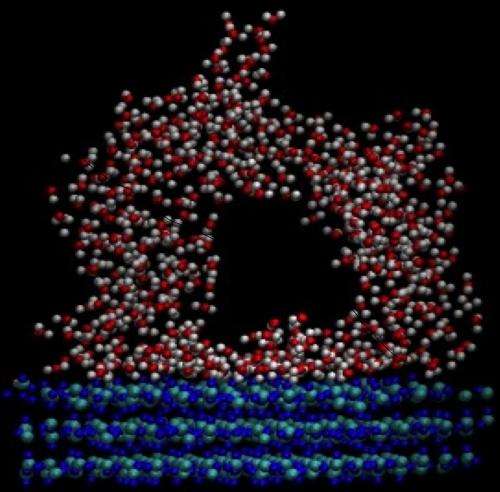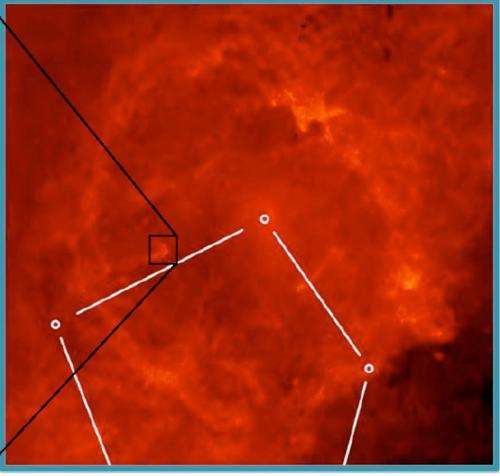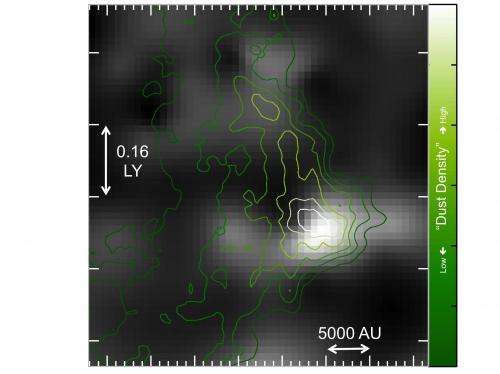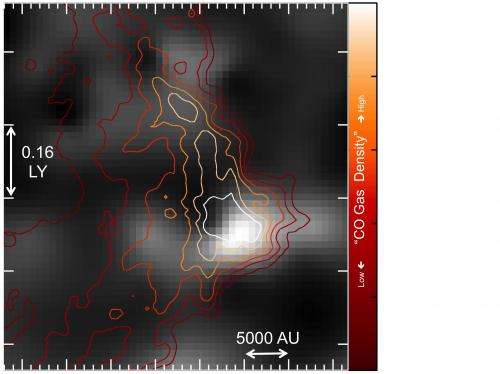Astronomers map icy wastes in space

(Phys.org) —Using the AKARI orbiting observatory, astronomers from the Open University have made the first large-scale maps of icy material where stars are forming. In a challenge to conventional ideas about the formation of water in space, they find ice in regions with little dust or gas. Dr Helen Fraser, who led the new work, presented the results in her talk at the National Astronomy Meeting in Portsmouth this week.
Launched by the Japanese space agency JAXA in 2006, AKARI (meaning 'light' in Japanese) surveyed 90% of the sky at infrared wavelengths until it ceased operations in 2011. The OU team used data from the observatory to make maps of the icy material in 28 star-forming regions, covering sections of the sky 10 arc minutes by 10 arc minutes (1 arc minute is 1/60th of a degree).
In the regions covered in the survey, temperatures are very cold (-263 degrees Celsius and 10 degrees above absolute zero) and pressures are low, with only a few hundreds to a few thousands of molecules in each cubic centimetre of space. Under these conditions, atoms and molecules of gas collide with the dust that is found there and form layers of 'frost' on the dust surfaces. These nano-scale icy dust grains are the chemical factories of star-formation, where successively more complex chemistry occurs. This in turn seeds the pre-biotic organic molecules that astronomers search for in the 'habitable zones' (where temperatures are right for water to be a liquid) around newly forming stars that may be inextricably linked to the origins of life.
The new AKARI maps are the first of their kind and in contrast to the prevailing model, suggest that ice is found in regions without much dust or gas. If ice can even form in these zones, it can quickly suck up or 'sorb' nearby gases, in the process changing local conditions, for example the amount of material available to form new stars and planets.
Dr Fraser sees this as a surprising discovery and one that could change our model for the formation of stars and planets.

She comments: "Until this research we never previously had a view of the cold solid-state universe, the icy freezers from which stars and planets ultimately form. Given that the results in our own local galaxy are so surprising, the question remains what other galaxies look like when we map their ice features."

Telescopes due to start operations in the 2020s, the James Webb Space Telescope and the European Extremely Large Telescope, will help researchers answer that question.

Dr Fraser continues: "The coming decade could be astounding. We could be able to apply the same technique to nearby galaxies and see if the nano-fabrication factories that make organic matter work in the same way across the different epochs of the history of the cosmos."
More information: www.ras.org.uk/nam2014
Provided by Royal Astronomical Society





















